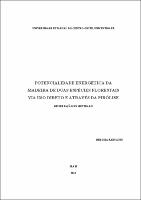| Compartilhamento |


|
Use este identificador para citar ou linkar para este item:
http://tede.unicentro.br:8080/jspui/handle/tede/444| Tipo do documento: | Dissertação |
| Título: | Potencialidade energética da madeira de duas espécies florestais via uso direto e através da pirólise |
| Título(s) alternativo(s): | Potential energetic of wood from two forest species through direct use and through pyrolysis |
| Autor: | Rancatti, Heloisa  |
| Primeiro orientador: | Watzlawick, Luciano Farinha |
| Primeiro coorientador: | Silva, Dimas Agostinho da |
| Resumo: | O presente trabalho objetivou a avaliação do potencial energético da madeira e do carvão vegetal da bracatinga (Mimosa scabrella Bentham) e da uva-do-japão (Hovenia dulcis Thunberg). O carvão vegetal foi obtido em laboratório através da pirólise da madeira empregando-se combinações de três temperaturas finais (300, 400 e 500°C) e duas velocidades de aquecimento (3 e 5°C/min). Foram determinadas as propriedades das madeiras por meio de sua caracterização (análise química imediata e elementar, poder calorífico superior e inferior) e posteriormente os parâmetros de qualidade do carvão vegetal pelo cálculo do rendimento gravimétrico e energético em carvão vegetal; percentual de gases não condensáveis e licor pirolenhoso; análise química imediata e elementar; poder calorífico superior e inferior; e friabilidade. Com base nos resultados obtidos concluiu-se que: a) As madeiras de bracatinga e uva-do-japão apresentaram diferença estatística apenas para o teor de materiais voláteis, teor de cinzas e de nitrogênio; sendo iguais para os demais parâmetros avaliados; b) O rendimento gravimétrico e energético em carvão vegetal diminuíram com o aumento da temperatura final da pirólise para as duas espécies estudadas; c) O rendimento em licor pirolenhoso não sofreu influência significativa da temperatura final e da velocidade de aquecimento; d) O aumento da temperatura final diminuiu o teor de materiais voláteis e aumentou o teor de carbono fixo e de cinzas; e) A temperatura final provocou alterações dos percentuais de carbono, hidrogênio, nitrogênio, oxigênio e enxofre do carvão vegetal, enquanto que a velocidade de aquecimento não foi significativa nos seus componentes elementares; f) O poder calorífico aumentou com o aumento da temperatura final para as duas espécies estudadas; g) O rendimento em carbono fixo não foi influenciado pela temperatura final e pela velocidade de aquecimento para a bracatinga e diminuiu com o aumento da temperatura final para a uva-do-japão; h) A friabilidade do carvão vegetal da uvado- japão não foi influenciada pelos dois fatores estudados, enquanto que a do carvão de bracatinga aumentou com o aumento da velocidade de aquecimento. |
| Abstract: | The present work aimed the evaluation of the energetic potential of wood and charcoal from bracatinga (Mimosa scabrella Bentham) and japanese grapes (Hovenia dulcis Thunberg). The charcoal was obtained in a laboratory by pyrolysis of wood employing combinations of three final temperature (300, 400 and 500ºC) and two heating rates (3 e 5°C / min). Was determined the properties of woods through their characterization (immediate chemical analysis and elemental, higher calorific value and lower) and later the quality parameters of charcoal by calculating the gravimetric yield and energetic in charcoal; percentage of non condensable gases and pyroligneous liquor; immediate chemical analysis and elemental, upper and lower calorific value, and friability. Based on the results obtained was concluded that: a) bracatinga and japanese grapes woods showed statistical differences only for the content of volatile materials, ash content and of nitrogen, being equal to the other parameters evaluated; b) The gravimetric and energetic yield in charcoal decreased with the increase of the final temperature of pyrolysis to the two studied species; c) The yield of the pyroligneous liquor was not affected by the final temperature and heating rate; d) The increase of final temperature reduced the content of volatile materials and increased the content of fixed carbon and ash; e) The final temperature caused alterations in the percentage of carbon, hydrogen, nitrogen, oxygen, and sulfur charcoal, while the heating rate was not significant in their elementary components; f) The calorific value increased with the increase of the final temperature for the two species; g) The yield in fixed carbon was not influenced by the final temperature and heating rate for bracatinga and it decreased with increase of the final temperature to the japanese grapes; h) The friability of the grape-of-japan charcoal was not affected by two factors studied, whereas the coal of bracatinga increased with the increase in heating rate. |
| Palavras-chave: | sem dados sem dados |
| Área(s) do CNPq: | SILVICULTURA::FLORESTAMENTO E REFLORESTAMENTO CIENCIAS AGRARIAS::RECURSOS FLORESTAIS E ENGENHARIA FLORESTAL RECURSOS FLORESTAIS E ENGENHARIA FLORESTAL::MANEJO FLORESTAL |
| Idioma: | por |
| País: | BR |
| Instituição: | UNICENTRO - Universidade Estadual do Centro Oeste |
| Sigla da instituição: | UNICENTRO |
| Departamento: | Unicentro::Departamento de Ciências Florestais |
| Programa: | Programa de Pós-Graduação em Ciências Florestais (Mestrado) |
| Citação: | RANCATTI, Heloisa. Potencialidade energética da madeira de duas espécies florestais via uso direto e através da pirólise. 2012. 89 f. Dissertação (Mestrado em Manejo Florestal) - UNICENTRO - Universidade Estadual do Centro Oeste, Irati, 2012. |
| Tipo de acesso: | Acesso Aberto |
| URI: | http://localhost:8080/tede/handle/tede/444 |
| Data de defesa: | 18-Abr-2012 |
| Aparece nas coleções: | Programa de Pós-Graduação em Ciências Florestais |
Arquivos associados a este item:
| Arquivo | Descrição | Tamanho | Formato | |
|---|---|---|---|---|
| Heloisa Rancatti_prot.pdf | 3,38 MB | Adobe PDF |  Baixar/Abrir Pré-Visualizar |
Os itens no repositório estão protegidos por copyright, com todos os direitos reservados, salvo quando é indicado o contrário.




